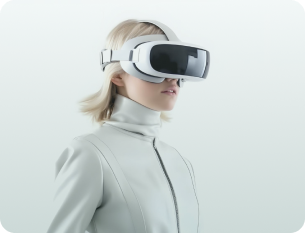
While virtual reality (VR) is still primarily associated with gaming, its applications extend far beyond entertainment. Today, VR is used across various sectors, including professional training and retail, and has shown considerable promise in mental health care.
One of the most validated uses of VR in psychotherapy is phobia treatment. Traditional exposure therapy helps patients face their fears in controlled environments. VR enhances this by offering virtual scenarios that replicate real-life situations with flexibility and safety.
For instance, someone with acrophobia (fear of heights) can be virtually placed on a high building or a narrow bridge, experiencing the physical symptoms of fear such as dizziness or increased heart rate. Since the environment is virtual, patients can pause or stop the session if overwhelmed. Repeated exposure to these situations in VR helps reduce anxiety, and over time, this new resilience transfers to real-life situations.
VR offers more control than traditional exposure therapy by allowing therapists to tailor the intensity of the experience according to the patient’s progress, a key advantage.
VR has also proven effective in treating post-traumatic stress disorder (PTSD), especially among veterans and survivors of traumatic events. VR allows for controlled reliving of traumatic experiences, helping patients desensitize to emotional triggers.
A well-known example is Bravemind, a VR therapy developed at the University of Southern California for veterans with PTSD. Immersed in realistic combat zones, patients gradually confront their traumatic memories under therapist supervision. Studies have shown significant improvements with VR-based PTSD therapy compared to traditional methods.
Additionally, VR is used in cognitive-behavioral therapy (CBT), enabling patients to practice new skills in realistic yet controlled settings. Social anxiety patients, for example, can rehearse public speaking or social interactions in virtual environments, preparing them for real-life situations.
One of the more controversial applications of VR in therapy involves grief counseling. Experimental programs have allowed people to “reunite” with deceased loved ones through virtual simulations. While this raises ethical concerns, the psychological benefits remain unclear. A well-known example is a South Korean TV show where a mother interacted with a virtual recreation of her deceased daughter. While it allowed her a sense of closure, critics argue that it may impede the natural grieving process by creating false expectations or fostering attachment to a digital fantasy.
The future of VR in therapy holds immense potential, offering customizable and controlled therapeutic environments. As VR technology evolves, so too will its applications in mental health. The integration of AI could further personalize treatment plans based on real-time feedback from patients.
However, VR will never replace the deep emotional connections vital for healing. Therapists must guide patients towards emotional independence, ensuring VR remains a supportive tool, not an escape from reality.
We’re here to help! Whether you have questions, need support, or want to know more about us and our services, fill out the form below and our team will get back to you promptly.
Let’s explore the future of AI and robotics together.
